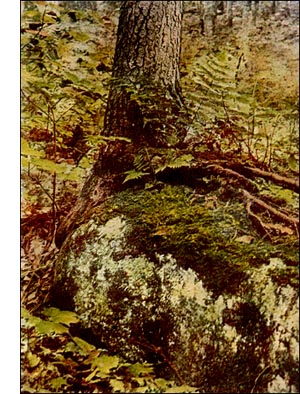Brachythecium Rivulare Moss
 Brachythecium rivulare, Bruch, Ms.
Brachythecium rivulare, Bruch, Ms.Habit and habitat. -Growing in dark or yellow-green mats on rocks and stones about springs and in swamps of mountainous woods.
Name.-The specific name rivulare refers to the habit of growing in wet places.
Plants (gametophyte).-Woody, prostrate, naked, or with rooting filaments, secondary stems ascending from old stems, arched 1/2 to 3 inches long, nearly free from branches below, irregularly branching above.
Leaves.-Branch leaves erect spreading, oval to oval lance shape, concave or somewhat grooved; apex acute to short taperpointed; margin with small sharp-pointed teeth above; base growing somewhat down the stem; vein extending 2/3 of the length of the leaf; cells, median, linear; basal, broader; alar, enlarged.
Habit of flowering.--Male and female flowers on different plants (dioicous).
Veil (calyptra).-Split up one side.
Spore-case.-Large, oblong or egg-shaped, horizontal or inclined.
Pedicel (seta).--Thick and rough, red-brown, 1 to 1 1/2 inches long.
Lid (operculum).-Conical, with an abrupt slender point.
Teeth (peristome).-As in the genus.
Annulus.-Large.
Spores.-Chestnut colour, mature in autumn.
Distribution.-Universal in mountainous regions.